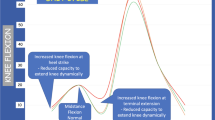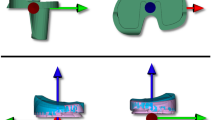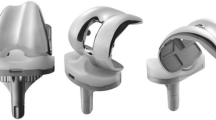Abstract:
The objective of this study was to measure three-dimensional knee motion during gait in patients with total knee replacements which either retained the posterior cruciate ligament (n = 11), or required sacrifice of the posterior cruciate ligament and replacement of its function with a posterior stabilizing articular surface (n = 9). Clinically meaningful translations (anterior and posterior, medial and lateral, proximal and distal) and rotations (flexion and extension, internal and external rotation, abduction and adduction) were measured using an instrumented spatial linkage. Although patients from both groups were able to achieve passive full extension and a minimum of 95° flexion, some of their translations and rotations during free speed walking were consistently less than those in a group of healthy controls. Motion during the swing phase of gait was similar for both knee replacement groups. However, abduction and adduction and proximal and distal translation were larger (but neither difference was significant) for the patients with implants with a posterior stabilizing surface, which suggests that the stabilizing surface may not reliably provide as much stability in these directions as does retention of the posterior cruciate ligament.
Similar content being viewed by others
Author information
Authors and Affiliations
Additional information
Received for publication on Aug. 28, 1997; accepted on June 10, 1998
About this article
Cite this article
Ishii, Y., Terajima, K., Koga, Y. et al. Gait analysis after total knee arthroplasty. Comparison of posterior cruciate retention and substitution. J Orthop Sci 3, 310–317 (1998). https://doi.org/10.1007/s007760050058
Issue Date:
DOI: https://doi.org/10.1007/s007760050058




